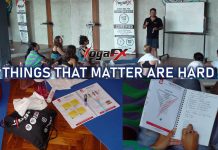Neuro-Linguistic Programming (NLP) has enormous benefits for both personal and professional applications.
NLP was derived by modeling the most successful people and practices in the world, and the NLP promise is that virtually any problem you have or any dysfunctional pattern you run, is malleable. That you can recreate this pattern in any way you wish, and that your past does not have to be an indicator of the future. For some people, a simple way to think about NLP is a set of techniques that can reprogram your nervous system through the use of language.
How did NLP come about?
NLP was created by Richard Bandler and John Grinder in the Santa Cruz Mountains in 1976. Now, Richard Bandler was a mathematician. He studied formulas. He was actually the teaching assistant for John Grinder who was a linguist, and he studied the structure of language. These two got together and posed a question.
“What if we could find a way to model what people who are really effective with communication do, reproduce that model, and teach it to other people?”
So Bandler and Grinder studied three people in particular. They modeled Fritz Perls who was a Gestalt therapist, Virginia Satir who was a family therapist, and Milton Erickson who was a hypnotherapist, and therein lies the connection between NLP and hypnosis, one of the many connections that we’ll come to find out.
How does NLP work and how can it improve your life?
You might know that for most, as we get upset with a situation, or our bandwidth shrinks. Our ability to be eloquent or creatively tackle an issue diminishes, and our ability to communicate effectively or purposefully gets more and more constricted as negative emotions take over.
Neuro-Linguistic Programming amplifies your ability to manage your own internal ‘state’, how you self-regulate. It’s great for helping you to stay resourceful during normally stressful times, be it personal or professional contexts, and it gives you a high degree of behavioral flexibility in difficult situations.
Does NLP work in my daily life?
NLP can really dramatically increase the speed with which you learn. Imagine if you knew how to learn most efficiently? Imagine if your internal neurological software was that efficient that you can just pick up new knowledge (that you like) in half the time. Well, you can have that.
Does NLP work as a tool?
NLP works as a tool that you can use to model and reproduce excellence in any field. One of the kinds of landmark modeling cases that was done in the early days of NLP was with Anthony Robbins and Richard Bandler. They were hired by the US government to model the sharpshooting program, and at the time, it took approximately four weeks to do the training with approximately a 20% pass rate.
Richard and Tony asked for the top five sharpshooters and modeled what they did differently from everyone else.
Does NLP work as a reproducible process?
In NLP virtually everything you do is a process. If you consider obsessive-compulsive behavior for a moment, most NLPers would contend that nobody has an Obsessive-Compulsive Disorder (OCD). They run a learned process of thinking and behaving that we label as OCD, or some might go as far as to say they have an obsessive “personality”. However, the problem is not necessarily the behavior, but the context. If it is applied to a constant and obsessive need for cleanliness, the individual might end up washing their hands compulsively until they have literally removed vital layers of skin.
Does NLP work for all?
Our senses pick up information from the world around us. We think we see the world as it is. That reality is just ‘out there and all we have to do is show up. That we see it for what it is. This is couldn’t be farther from the truth. The world around us is the territory, but we NEVER see the world as it is. We are limited by our own perceptual filters. The world is so vast and there is just so much information to absorb that we cannot possibly manage it. Out of an estimated 2 million bits of information per second that comes flooding through our senses, that there are only about 134,000 bits that we can actually absorb. (George A Miller Theory of Chunking 1956).
This leads to perceptual deficits. The best we can manage is to create what might be best. This is how we learn. We essentially store experiences for later use. Once we know what a door is for, we will have a basic recognition of how to use it. The downside is, that any map is at best an interpretation of the territory. It is not the territory.
CLICK HERE For More Course Inclusions and Our June Main Event![]()


















































